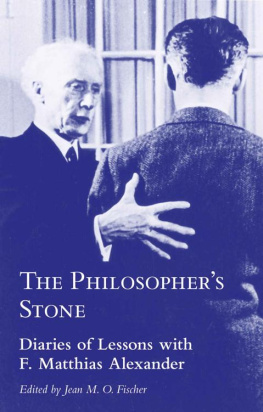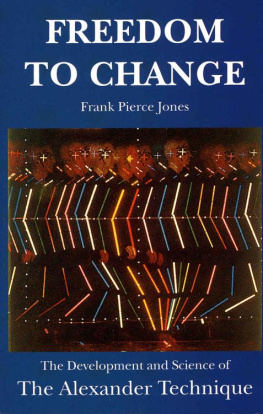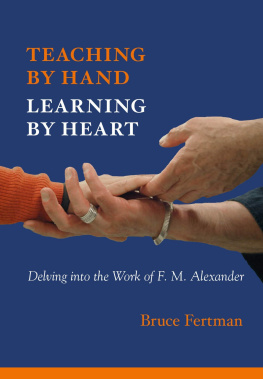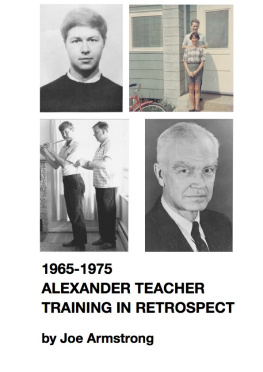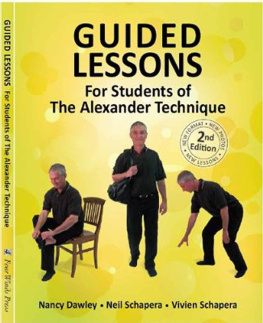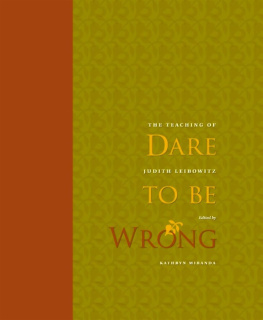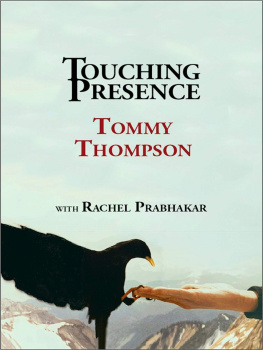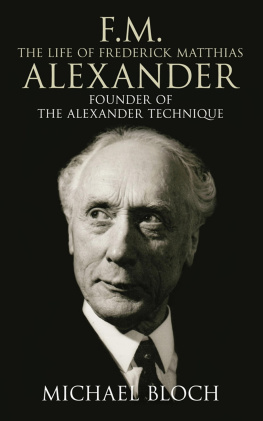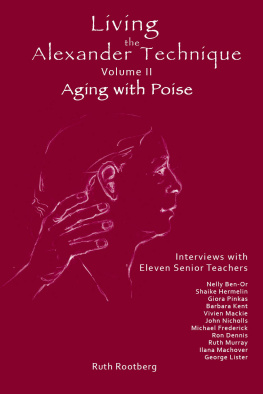by Jean M. O. Fischer
by Miss G. R and Louise Morgan
Introduction
The Philosophers Stone belongs to those visionary, but impossible, human endeavours in which our reach exceeds our grasp. The quest for the unattainable, however, provides a study of human needs and longings because it permits unrestrained projection of our innermost desires. The Philosophers Stone reflected the aspirations for the transmutation of the ordinary into the extraordinary; for health and long life; and for a quintessence yet to be discovered, a law of nature or a principle of life vital to our well-being. When F. M. Alexander developed a technique for the conscious use of the self he developed something eminently practical and realizable which, perhaps incidentally, fulfills some of the aspirations which the Philosophers Stone represents.
Given that Alexander taught individually and that thirty lessons was the recommended minimum, he must have taught several thousand pupils in his sixty-one-year career. Contemporary descriptions of F. M. Alexander giving lessons in his technique are, however, rare. This collection, from a wide variety of sources, ranges from c. 1918 to c. 1953, and documents a range of different perspectives, interpretations and engagements.
The Philosophers Stone by James Harvey Robinson is a review of Alexanders first book, Mans Supreme Inheritance . As well as being a consummate and enduring introduction to the Technique, the review also contains Robinsons description of Alexander teachingthe earliest account by a pupil.
James Harvey Robinson (18631936) was an American Professor of History as well as a Doctor of Law and Doctor of Humane Letters. Robinson specialized in European history, and lectured at the New School for Social Research, New York, 191921. In addition to several history books he wrote The Mind in the Making (1921), which presents an outline of the evolution of thought, aiming to explain and recommend the essential importance of free thought in mans progress. Although the Technique is not mentioned by name, a footnote refers to it: The relation of our kinesthesia or muscular sense to fanaticism on the one hand and freedom of mind on the other is a matter now beginning to be studied with the promise of highly important results.
Robinson was probably introduced to Alexander by John Dewey, who also had lessons. (Alexander lived in London but during the period 191624 he spent six months out of every year in New York and Boston.) The revised edition of Mans Supreme Inheritance was published in the USA in January 1918, and Robinsons review was published in the influential cultural review The Atlantic Monthly in April 1919.
Eva Webbs Diary of My Lessons in the Alexander Technique was first published in George Bowdens F. Matthias Alexander and the Creative Advance of the Individual in 1965. Eva Webb, who had lessons in 1947, describes herself as a busy housewife. She had her first lesson with Alexander and subsequent lessons with some of his assistant teachers: Irene Stewart, Patrick Macdonald, Maxwell Alexander, Margaret Goldie, Richard Walker and Walter Carrington. It was Alexanders practice to give an initial consultation and the first lesson, after which a pupil might be taught by one of his assistant teachers.
Webbs diary faithfully depicts what it was like to have lessons at the time at 16 Ashley Place, London S.W.1., Alexanders home and teaching practice.
The Diaries of Frank and Grace Hand has been prepared from a photocopy of the original handwritten notes.
Frank Hand (191491) and his mother, Grace (d. 1947), belonged to an offshoot of Christian Science known as The Society of Life, started by Annie C. Bill and continued by Francis J. Mott. Mott claimed that he had found a true leader in Alexander, but, as Frank Hand said later, Of course, Alexander didnt want to be a Messiah for The Society of Life.
Recommended by Mott, and wanting to improve his back in order to join Naval Intelligence, Frank started having lessons in April 1942. He was at the time a government lawyer in Washington and stayed in New York for the duration of his lessons. His notes were written in his hotel after each daily lesson. He later said about the process of writing: It was torture to try and remember.... I couldnt quite grasp it for a long time. He had more lessons than the six related here, sometimes with A. R. Alexander, but he didnt write about these. (Frank said about A. R: After every lesson he had a drink of gin. But it was marvellous gin.)
Frank later recounted his evening meetings with F. M. Alexander: Every other night wed go to dinner. After wed come bac k.. . he had to have that cigar. Im not sure [which] but it was a good one. And he could smoke that cigar longer than anybody I had ever seen. And he would have two inches of ashes at the end of that cigar and it wouldnt come off. Thats an accomplishment! I think that to him that was the epitome of showing somebody there was no end-gaining; there was no effort on his part to smoke that cigar.... He would give me one of his readings. We would sit there and I would comment on it ... . He would be somebody from Macbeth ... . He had the heaviest, hardest neck Ive ever seen. The back of his neck was just like that table and straight as an arrow. It looked like his head was always forward.... And when he would smoke, it looked like he would smoke in slow-motion. And those readings were marvellous.... You could almost see the person that he was imitating.
Frank Hands mother, Grace, made notes of her daily nineteen lessons in August and September 1942.
Some of Frank and Graces wording is unfortunate insofar as it indicates a forceful manipulation which is not part of the Technique. For example, in the case of push or thrust, teachers would use direct or guide; for twist, teachers would use rotate or turn, etc. Their spontaneous impressions, however, provide examples of how pupils with little previous knowledge apprehend the Technique.
Recording of a Miracle was first published in Louise -Morgans introduction to the Technique, Inside Yourself , in 1954. The diary was written by a Mrs Buchanan under the pseudonym of Miss G. R. Her ill-health led to her having lessons with Alexander. It was her remarkable recovery which -inspired Louise Morgan to write her book and incorporate an abbreviated version of Mrs Buchanans diary. The complete chapter from Inside Yourself , which is reproduced here, includes Louise Morgans introduction. Another extract from the diary, quoted later in Louise Morgans book, is also included.

